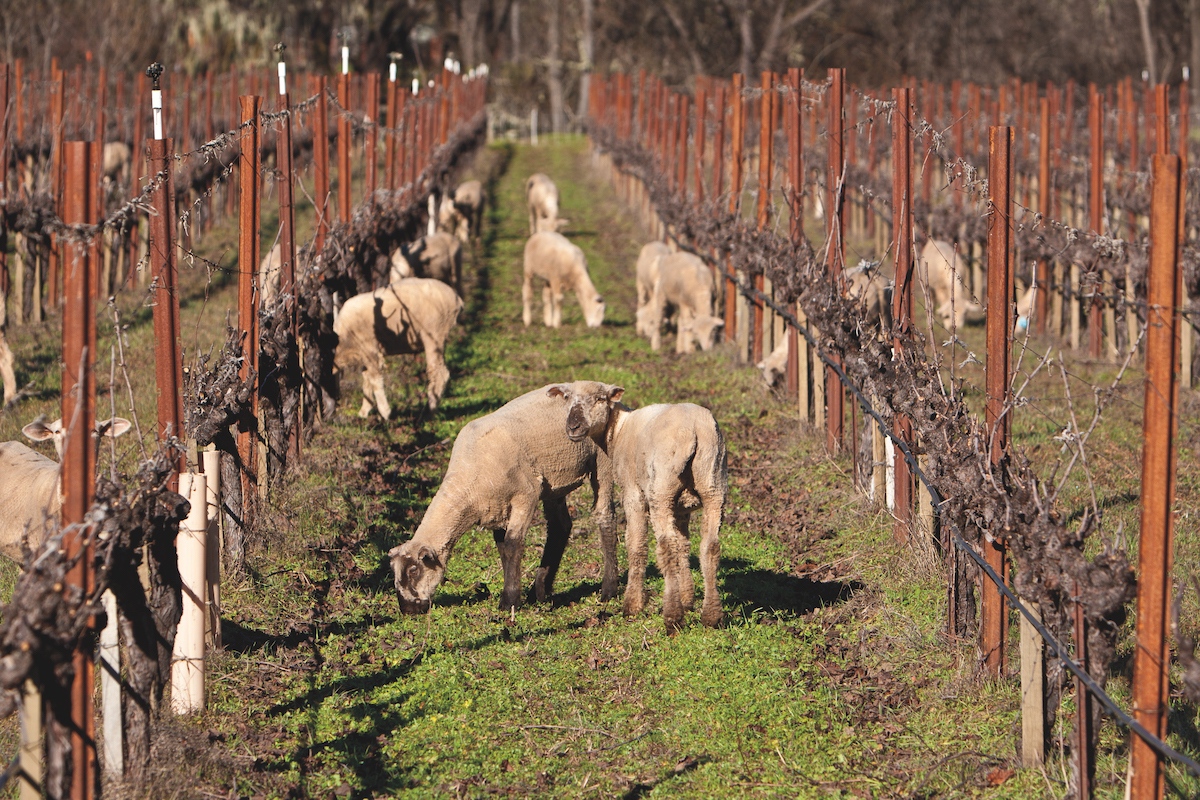California Sustainable Winegrowing Alliance programs promote sustainability
California is the fourth-largest wine producing region in the world. With that accolade, wineries have a great responsibility to protect the land and the environment. In this Sustainable, Secure Food blog, Lisa Francioni-Hai explains how the California Sustainable Winegrowing Alliance makes this happen:two sheep grazing in grape vineyard
Sustainable wine production uses practices that are environmentally sound, socially equitable and economically viable. Grape growers and vintners, the people who make wine, follow sustainable practices throughout California to grow and make high quality grapes and wine.
Sustainable vineyards and wineries:
conserve water and energy;
maintain healthy soil;
protect air and water quality;
enhance relations with employees and communities;
preserve local ecosystems and wildlife habitat; and,
improve the economic vitality of vineyards and wineries.
Some examples of sustainable practices include:
Grazing sheep and providing habitat for beneficial birds to control weeds and pests
Using cover crops, (e.g., clover, peas, and mustard) to prevent erosion and to increase soil health;
Installing drip irrigation to use less water;
Collecting runoff and rain to conserve water and decrease pollution;
Composting, recycling, and reusing waste materials like vine pruning clips, pumice, leaves, stems, pressed grapes, etc.;
Preserving local ecosystems and wildlife habitats to increase biodiversity; and,
Providing employee training.
California Sustainable Winegrowing Alliance
The California Sustainable Winegrowing Alliance is a partnership between growers and vintners. Established in 2003, it promotes sustainability from grapes to glass. In the last two decades, the educational programming has grown. The state’s growers and vintners have been using sustainable winegrowing practices for decades.
In 2010, The Alliance also set up a certification program called Certified California Sustainable Winegrowing. This program has a robust collection of educational resources that includes the California Code of Sustainable Winegrowing, covering over 200 sustainability practices.
As the fourth largest wine-producing region in the world, California has one of the most comprehensive and widely adopted sustainable winegrowing programs. The community fosters a culture of continuous improvement and leadership in sustainability.
What is Certified California Sustainable Winegrowing?
Certified California Sustainable Winegrowing provides annual third-party verification. Auditors verify that a winery or vineyard follows stringent sustainable winegrowing standards. Auditors also verify the wineries and vineyards are committed to continuous improvement in sustainability.
In addition to using required practices, companies decide what areas need to be improved. They focus their resources on practices that will make the most difference for their sustainability goals. Vineyards and wineries must also meet an overall score threshold to renew their certification year after year. They measure and track metrics for water, energy, greenhouse gas emissions, and nitrogen. They also must follow restrictions on crop-protection materials.
Currently, Certified California Wineries make 92% of California wine. Over 2,000 vineyards are certified, spanning 76,672 hectares of land. Certified wineries source at least 85% of their grapes from certified vineyards, and 100% of their grapes must come from California.
A Commitment to the Future
California vineyards and wineries are dedicated to the land. They strive to keep a healthy and beautiful environment for themselves, neighbors, and wine-country visitors. As mostly family-owned businesses, they make long-term decisions to pass on thriving businesses to future generations. Their dedication to sustainability reflects their desire to be world-class producers known not only for high-quality wines, but also for the conscientious way in which they produce them.
Ms. Francioni-Hai presented at the 2020 Sustainable Agronomy Conference offered by the American Society of Agronomy. Listen to her talk here.
To learn more about California Wines and the industry’s sustainability commitment, visit www.discovercaliforniawines.com.
To view lists of Certified California Sustainable Wines, Wineries and Vineyards, visit: https://www.sustainablewinegrowing.org/CCSW-certifiedparticipants.php
About us: This blog is sponsored and written by members of the American Society of Agronomy (ASA) and Crop Science Society of America (CSSA). Our members are researchers and trained, certified professionals in the areas of growing our world’s food supply while protecting our environment. They work at universities, government research facilities, and private businesses across the U.S. and around the world.
Learn more about crop science and agronomy, then follow us on Twitter (@ASA_CSSA_SSSA), Instagram (@sustainablefoodsupply), and Facebook (@ASA.agronomy and @CSSA.crops).
Media release and image provided by Rachel Schutte, Science Societies. Photo: Grazing sheep in vineyards help control weeds, and the grazing provides food for the sheep. Credit: Wine Institute.


